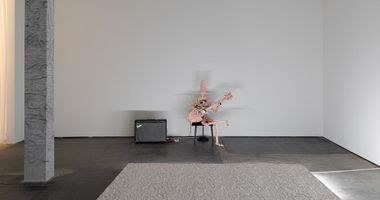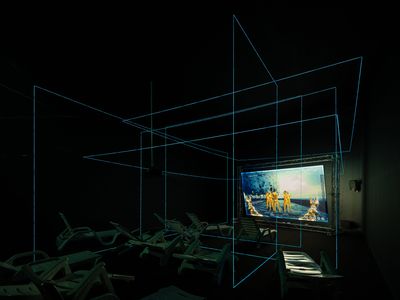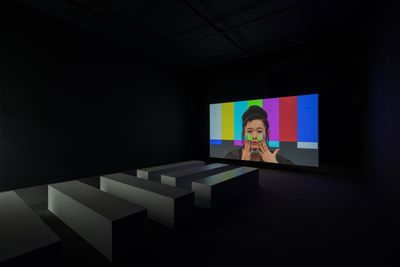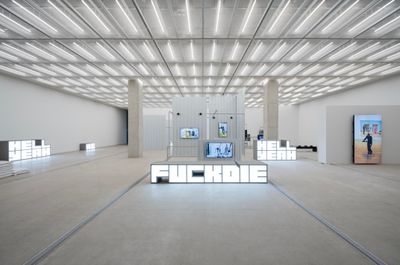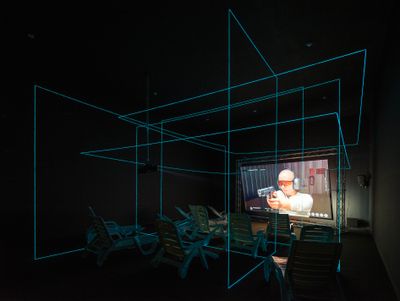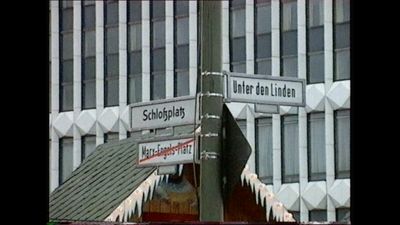Hito Steyerl: Rule-Breaking in the Data Society

Hito Steyerl, Hell Yeah We Fuck Die (2016). Exhibition view: Hito Steyerl – A Sea of Data, MMCA, Seoul (29 April–18 September 2022). Courtesy MMCA, Seoul.
In a world where NFTs and the metaverse have gained prominence, Hito Steyerl's works remind us to reflect on existing rules and patterns to break them in the best possible way.
Consisting of five sections, Steyerl's first solo show in Asia, Hito Steyerl – A Sea of Data at the National Museum of Modern and Contemporary Art, Korea in Seoul (29 April–18 September 2022), encompasses 23 works, from early film essays to the artist's recent video installations.
As with Steyerl's e-flux essay 'A Sea of Data: Apophenia and Pattern (Mis-) Recognition' (2016), the show offers a new perspective on today's digital society, rampant with data, images, and algorithms.1
In the first section, 'A Sea of Data', which is titled after Steyerl's essay, a newly commissioned work Animal Spirits (2022) is a four-channel video installation taking after British economist John M. Keynes' term 'animal spirits', which refers to the ways emotions like fear or desire influence consumer decisions and the financial market.
Steyerl shows a digital world 'in which human lives and even nature can become data that can be mined, controlled, and cultivated.'
In the darkroom, the three-channel video of Animal Spirits (2022), displays a sort of rock-art pattern creating a path to walk around, while small, glow-in-the-dark plants held in circular glass cylinders fixed to the ceiling add to the cave-like ambiance.
At the entrance to this cave-like room, the main single-channel video tells a fictional narrative of Nell and his journey to becoming a 'quantum shepherd'. The film follows Nell from his small village in Spain, as he appears in multiple locations, wearing a wolf skin, playing his pipe, fighting forever against fascists, Disney ecologists, and bureaucrats.
In Animal Spirits (2022), a reality T.V. show about shepherds is halted due to the pandemic and producers instead create 'Crypto Colosseum'—animal fighting in the metaverse. Each time an animal burns, an NFT is minted and recorded on the blockchain as a digital asset.
Blue lighting lines, appearing in previous landmark video installations such as Factory of the Sun (2015), and included in this section, cover the mountain and 3.D.-rendered animal fighting, referring to indiscernible agency and power dynamics in a data-centric society.
This NFT-based animal fighting is juxtaposed with a 3.D.-rendered Keynes explaining 'animal spirits', and shepherds create their own exchange systems, like 'Cheesecoin', which is 'coded in the bacteria based blockchain'.
One 3.D. wolf escapes from the 'Crypto Colosseum' and goes to the Lascaux caves in France where a dog named Robot fell into in the 1940s and found prehistoric paintings. The angry shepherd Nell rejects this happy ending and becomes a quantum shepherd.
By connecting reality television to NFT survival, Steyerl critically and wittily shows a way of seeing the digital world as one in which human lives and even nature can become data that can be mined, controlled, and cultivated.
In the second section, the single-channel video How Not to Be Seen: A Fucking Didactic Educational .MOV File (2013) explains—across a five-chapter manual—ways to not be seen in this digital world, inspired by the 1970s British comedy series Monty Python's Flying Circus.
In the film, Steyerl gives a lesson on 'how to be invisible by disappearing'—notably by 'being a dead pixel', 'being undocumented', and 'being spam caught by a filter'.
After this tutorial, the film says, 'in the decades of digital revolution, 170,000 people have disappeared: deleted, omitted, and segregated.' In the world that becomes an image, what is seen or not seen, and the hierarchy of images, are decided by algorithms.
Hell Yeah We Fuck Die (2016), a five-video installation in the third section, further inquires about how the world is reshaped by algorithms and artificial intelligence. Scattered across the exhibition space, light boxes made into chair installations spell out the five most common words in song titles from 2010 to 2015—'Hell', 'Yeah', 'We', 'Fuck', and 'Die'.
Through these juxtapositions, as with reality T.V. and the NFT market, or Nell, Jacob, and herself, Steyerl highlights patterns within global society.
The work includes a three-channel video framed by a grid-shaped metal structure and an iron gate. In the video, a humanoid robot developed for rescuing people during disasters is relentlessly attacked and stumbled on as part of his training.
At the entrance of the same section, one of the two aluminium and foam blue robots from Prototype 1.0 and 1.1 (2017) featured in the video is knocked out cold on the ground, making visible the violence incurred in the process of technological development.
On the other side of the space, the single-channel video Robots Today (2016) shows the city of Diyarbakir on the Turkish-Syrian border, devastated by the long-running conflict between Turkish security forces and the Kurdistan Workers' Party. In the video, children ask Siri if robots can actually rescue people in disaster areas, but Siri doesn't understand.
Steyerl's video installations often include images that are mirrored by objects installed in the physical space. In the fourth section, Liquidity Inc. (2014), a single-channel video that includes a water-reminiscent, blue architectural structure further reveals how our current digital society is not only an image that can be controlled, but is circulated, as with the flow of water.
Jacob Wood, the film's protagonist, is a Vietnamese war orphan who worked as a financial analyst before becoming a mixed martial arts fighter and commentator after getting fired during the global financial crisis of the late 2000s. Steyerl compares the fighting flexibly in the ring to the fluidity of the financial market, drawing similarities between the circulation of capital, information, and the liquidity of water.
Through these juxtapositions, as with reality T.V. and the NFT market, or Nell, Jacob, and herself, Steyerl highlights patterns within global society. Often organised into chapters, each video is like a tutorial for surviving a data flooded, monitored, and concealed world.
The last section consists of Steyerl's early documentary film essays, including The Empty Centre from 1998. The film notes the violence inherent to the empty space where the former Berlin Wall stood, stretching between Potsdamer Platz and the Reichstag in Berlin.
In this space, throughout history, as one border was slowly taken down, new ones relentlessly appeared. A reality Steyerl records over an eight-year period, while looking into the layers of history, noting architectural changes, events of gentrification and racism, and protests opposing the hiring of low-wage foreign workers after World War II.
From the survival of the fittest to the realities of war, violence constantly circulates. But just as we seem trapped in the Möbius strip, where our lives are stored in 'big data', Steyerl's images reveal that we can break free. —[O]
1 Hito Steyerl, 'A Sea of Data: Apophenia and Pattern (Mis-)Recognition', e-flux #72, April 2016, https://www.e-flux.com/journal/72/60480/a-sea-of-data-apophenia-and-pattern-mis-recognition/.







